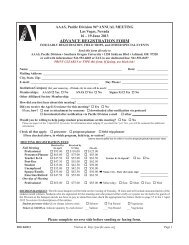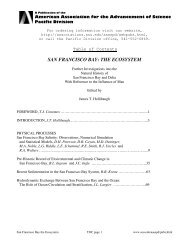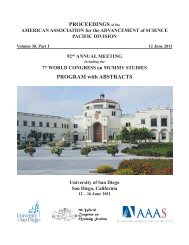Vol 31, Part I - forums.sou.edu ⢠Index page - Southern Oregon ...
Vol 31, Part I - forums.sou.edu ⢠Index page - Southern Oregon ...
Vol 31, Part I - forums.sou.edu ⢠Index page - Southern Oregon ...
You also want an ePaper? Increase the reach of your titles
YUMPU automatically turns print PDFs into web optimized ePapers that Google loves.
ABSTRACTS – Contributed Posters<br />
EDUCATION<br />
183 Who is Teaching with Electronic Books and Why<br />
A Survey of <strong>Oregon</strong> State University Faculty, LAUREL<br />
KRISTICK* and MARGARET MELLINGER (<strong>Oregon</strong><br />
State University, 121 The Valley Library, Corvallis, OR,<br />
97<strong>31</strong>1; laurel.kristick@oregonstate.<strong>edu</strong>).<br />
<strong>Oregon</strong> State University (OSU) Libraries owns over<br />
29,000 electronic books (e-books) ranging from handbooks<br />
and encyclopedias to scholarly monographs. Several years<br />
ago, the Libraries chose to convert most journals to electronic<br />
format, and there is now a similar movement for books. To<br />
better understand the choices involved, information about how<br />
faculty currently use e-books in teaching and research was<br />
needed. The authors recently surveyed a sample of OSU faculty<br />
to determine their awareness of the Libraries’ collections, their<br />
use of the collections for teaching and research, and their<br />
reasons for using or not using electronic books.<br />
The authors will present findings from the survey related<br />
to faculty use of electronic books in teaching. The presentation<br />
will include how faculty responses varied by college and by<br />
length of time teaching at the institution, as well as the reasons<br />
given for using or not using e-books in teaching.<br />
184 AMOEBA: Authentic Mentoring of Engaged Biologists<br />
Alliance at Idaho State University, JEFFREY P HILL*,<br />
BRUCE P FINNEY, and CAROLYN F WEBER<br />
(Department of Biological Sciences, Idaho State University,<br />
921 South 8th Avenue, Stop 8007, Pocatello, ID 83209-<br />
8007; hilljeff@isu.<strong>edu</strong>).<br />
This pilot project fuses teaching and research<br />
activities within a newly established mentored learning<br />
community (AMOEBA) with levels of expertise that<br />
span from undergraduate freshmen to life science PhDs.<br />
Incoming students are first invited to become “scientific<br />
learners” (i.e., to adopt the best learning practices based<br />
on data-driven evidence available in the science <strong>edu</strong>cation<br />
literature). AMOEBA embraces a central National Science<br />
Foundation tenet that biology is a discovery science<br />
by providing students at the threshold of their higher<br />
<strong>edu</strong>cation direct experiences in research. Student-centered<br />
learning accomplished through research-focused activities<br />
is expected to yield genuine primary data for professional<br />
dissemination in contexts where early career students can<br />
legitimately realize creative and intellectual ownership<br />
of their work. A goal for the project is to attract researchactive<br />
biology faculty members, graduate students and<br />
advanced undergraduates as experienced mentors in an<br />
alliance that includes lower division biology students.<br />
Research modules link faculty expertise and interests<br />
directly with experiential learning opportunities to enhance<br />
students’ understanding of core concepts and competencies<br />
that ultimately contribute to the development of lifelong<br />
biological literacy.<br />
102<br />
HISTORY and PHILOSOPHY of SCIENCE<br />
185 Rediscovering Emilie du Chatelet: A Scientist and<br />
Pholosophe of the French Enlightenment, NICHOLE<br />
SNYDER (Department of History, Boise State University,<br />
1910 University Drive – MS 1925, Boise, ID 83725;<br />
nicholesnyder@u.boisestate.<strong>edu</strong>).<br />
Known primarily throughout history as the lover of<br />
<strong>Vol</strong>taire, scholars over the last decade have rediscovered<br />
the significance of Emilie du Chatelet as a contributor<br />
to scientific development in the French Enlightenment.<br />
As one of the earliest female scientists, her life illustrates<br />
that although it was difficult, it was possible for a woman<br />
to be defined by the complexity and the success of her<br />
own scientific accomplishments such as her impressive<br />
translation of Newton’s Principia that is still in use today.<br />
Historically significant female scientists are little known<br />
prior to the twentieth century, but through comparing the<br />
way scholars have treated Emilie du Chatelet in the past and<br />
the work of historians today of the significance of her life, it<br />
is clear her image is changing. Emilie du Chatelet deserves<br />
recognition not only for her role as a philosophe in the French<br />
Enlightenment but a scientist in her own right.<br />
ANTHROPOLOGY and ARCHAEOLOGY<br />
186 Investigation of Histomorphometric Values in an<br />
East Arctic Foraging Group, the Sadlermiut, JOSEPH<br />
PURCELL 1 *, MARGARET STREETER 1 , EMILINE<br />
RAGUIN 2 , BRIDGET DENNY 1 , MICHELLE<br />
DRAPEAU 2 , and RICHARD LAZENBY 3 ( 1 Department<br />
of Anthropology, Boise State University, 1910 University<br />
Drive, HWSC Room 115, Boise, ID 83725; 2 Departement d’<br />
anthropologie, Universite de Montreal, PO Box 6128, Station<br />
Centre-Ville, Montreal Canada, H3C 3J7, m.drapeau@<br />
umontreal.ca; 3 Department of Anthropology, University of<br />
Northern British Columbia, 3333 University Way, Prince<br />
George BC, Canada V2N 4Z9; Lazenby@unbc.ca).<br />
A sample of second metacarpals (n=78) obtained<br />
from the Sadlermiut, Inuit (1285-1903 A.D.), a genetically<br />
isolated East Arctic foraging group, was analyzed in this<br />
study. The Sadlermiut subsisted nearly exclusively on small<br />
marine mammals and fowl. Based on known adaptations to<br />
a cold environment, a high level of physical activity and a<br />
diet high in protein, it was predicted that Inuit bones would<br />
show elevated levels of cellular activity. The size and density<br />
of secondary osteons in the Sadlermiut are used in this study<br />
to compare their bone metabolic processes with known data<br />
from a sample of Euro-Canadian metacarpals (n=63) from<br />
an historic cemetery in Ontario, Canada. Exact ages were<br />
known for the Euro-Canadian group, while the individuals<br />
in the Inuit sample are only known as young, middle and<br />
old. Student’s t-tests were used to investigate variation








